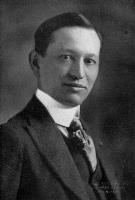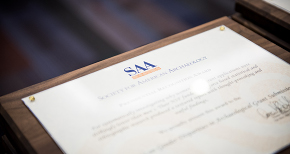The Society for American Archaeology (SAA) offers two Native American Scholarships that honor the legacies of pioneering Native archaeologists and scholars:
- The Arthur C. Parker Scholarship for Archaeological Training for Native Americans
- The Bertha Parker Cody Award for Native American Women
These scholarships support archaeological training, and undergraduate and graduate studies for Native American, Alaska Native, and Native Hawaiian students.
Learn more about the individuals whose names these awards carry below.
Arthur C. Parker (1881-1955)

Arthur Caswell Parker was the first president of the Society for American Archaeology, serving from 1935 to 1936. Of Seneca ancestry through his father’s family, Parker spent his early years on the Cattaraugus Reservation in western New York.
His career spanned archaeology, cultural anthropology, and history, and he was instrumental in developing museum anthropology and advancing public education about Indigenous cultures. Parker was also deeply engaged in social and political issues affecting Native communities during his lifetime, using his scholarship and leadership to advocate for Native perspectives within the broader archaeological field.
(Photo: Arthur C. Parker in 1918. From The Life of General Ely S. Parker, Buffalo Historical Society, 1919, p. 201.)
Bertha Parker Cody (1907-1978)
_(1907-1978)_(6891503755)-credit-smithsonian.tmb-thumb200.jpg?sfvrsn=c96e94ed_1)
Bertha Parker Cody was the first Native American woman archaeologist and ethnologist in the United States. The daughter of Arthur C. Parker (Seneca) and Beulah Tahamont (Abenaki), she was introduced to archaeology as a child while accompanying her father on excavations.
As an adult, her uncle by marriage, archaeologist Mark Raymond Harrington, invited her to work at an excavation site in Nevada, where she gained formal training in field methods. In 1930, she made a groundbreaking discovery—a Pleistocene sloth skull found with human artifacts at Gypsum Cave—which challenged long-held assumptions about early Native American occupation in the Americas (Bruchac 2018:96–99).
In 1933, the Southwest Museum hired her first as a secretary and later as an assistant archaeologist and ethnologist. There, she catalogued artifacts, prepared field reports, and conducted ethnological research on California Indian tribes, including the Maidu, Yurok, Pomo, and Paiute (Bruchac 2018:101–104).
Throughout the 1930s–1960s, Parker Cody published numerous articles in the Southwest Museum’s journal Masterkey, sharing her archaeological and ethnological findings. Her work helped document and preserve Indigenous histories during a period when few Native voices were represented in American archaeology.
The Bertha Parker Cody Award commemorates her trailblazing achievements and lasting contributions to archaeology and ethnology.
Bruchac, Margaret (2018). Indigenous Informants and American Anthropologists. University of Arizona Press, Tucson.


